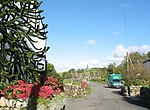Llanllyfni

Llanllyfni (Welsh pronunciation) is a village and a community in Gwynedd, Wales. It is in the historic county of Caernarfonshire. The community consists of the villages of Drws-y-coed, Nantlle, Nasareth, Nebo, Penygroes, Talysarn and the village of Llanllyfni itself. Penygroes, Llanllyfni and Talysarn are almost conjoined. As an electoral ward the 2011 census recorded a population of 1256. It is a largely Welsh-speaking village as 85% of the villagers speak Welsh as their first language. The community covers 43 square kilometres.The river Afon Llyfni (sometimes spelt Afon Llyfnwy) runs through the village. Llanllyfni existed before the slate quarries opened but grew bigger and bigger during the slate quarrying period. In the 2001 census, there were about 650 people living in the village of Llanllyfni. Llanllyfni is seven miles away from the well-known town of Caernarfon. Nearby is the Nantlle Ridge range of mountains including Craig Cwm Silyn at 734 metres (2,408 feet).
Excerpt from the Wikipedia article Llanllyfni (License: CC BY-SA 3.0, Authors, Images).Llanllyfni
Ger y Llan,
Geographical coordinates (GPS) Address Nearby Places Show on map
Geographical coordinates (GPS)
| Latitude | Longitude |
|---|---|
| N 53.045 ° | E -4.282 ° |
Address
Ger y Llan
Ger y Llan
LL54 6DJ , Llanllyfni
Wales, United Kingdom
Open on Google Maps










